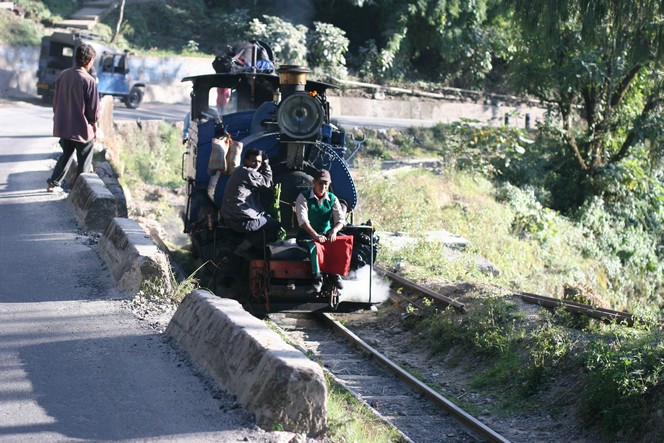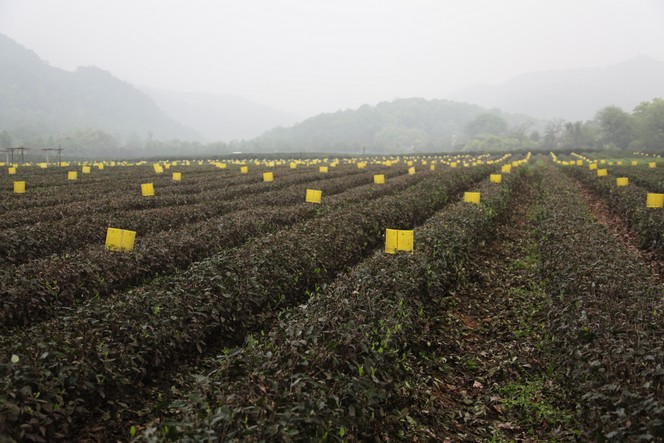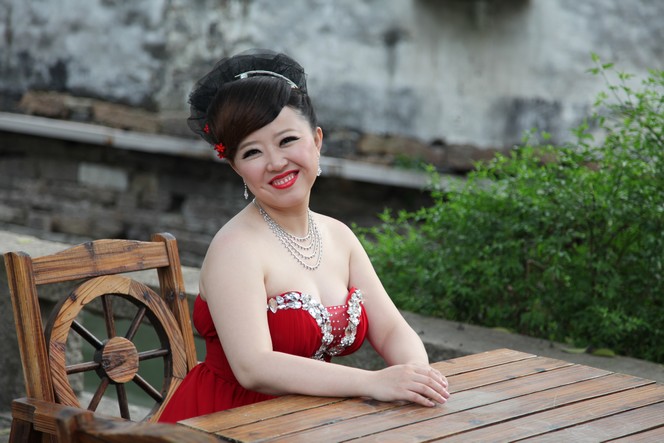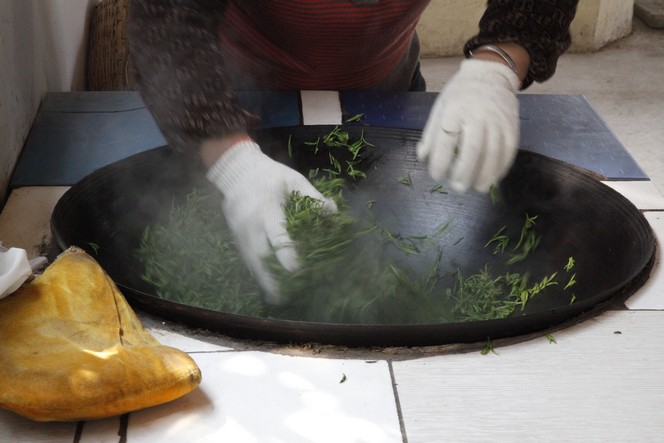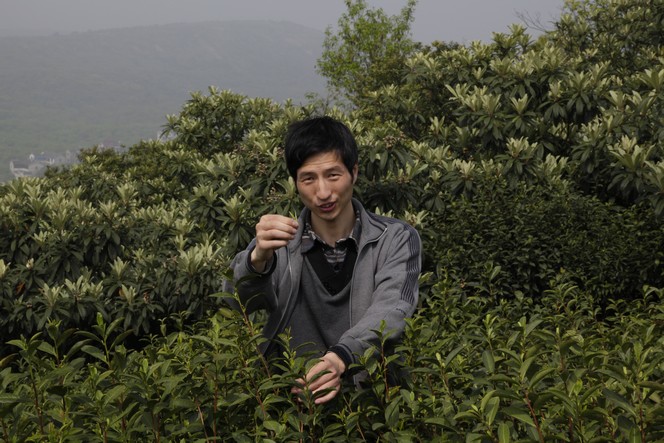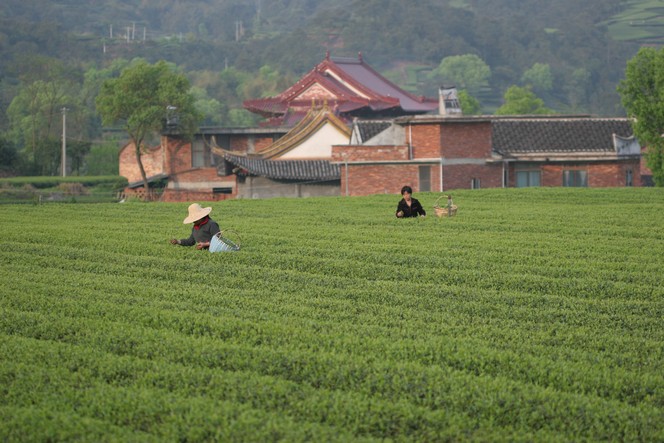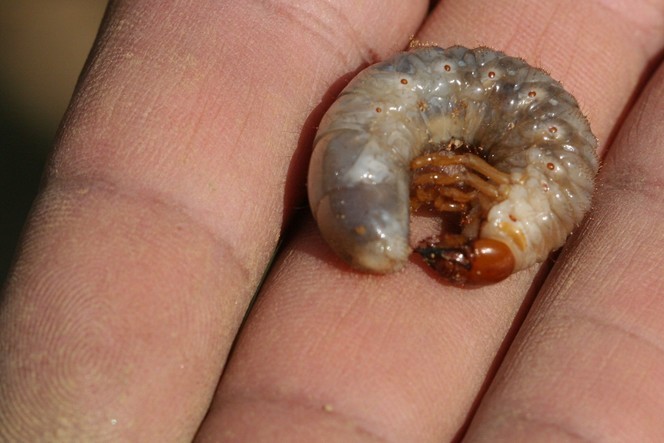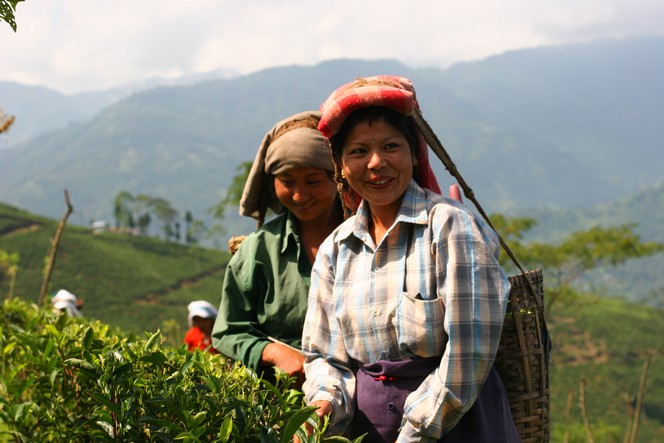The little Darjeeling train is completely unpredictable. From time to time it travels without carriages. A few lucky passengers seem to be allowed though, on condition that they can hold a contorted pose for a long time. They hang their bags wherever they can, and simply put any other luggage on the roof of the locomotive.
Panels for trapping harmful insects
On the tea plantations there are plenty of ideas for trapping harmful insects. For example, here in Hangzhou, they place little panels covered in glue everywhere among the tea plants. The fluorescent yellow of the boards attracts the insects, but most of all it is the pheromones in which they are coated that appeals so much to bugs.
These are clearly unrelated to all the election boards that are flourishing, right up until this weekend, all around our voting stations.
On the tea routes with my colleagues
Most of the time I travel the tea routes alone, but I also really enjoy sharing with my colleagues the pleasure of walking among the tea plants and observing all the stages of the processing. These trips are very rewarding because we can spend time together talking about our shared passion, understanding, learning, tasting all sorts of teas, and discussing them endlessly. Here, on the right of Waterqian, who produces Bi Luo Chun, and in the middle of his tea garden, are Aurélie, Carine, Cyrille and Mathias. I took this photo last week.
Newly wed Chinese couples love going to Suzhou
The city of Suzhou is full of character. Many Chinese tourists come here to find some old-world charm. In the historic part of the city, canals run alongside the narrow streets, and many newly wed Chinese couples come here to make pictures. In fact you cannot walk more than a few paces before coming across a pair of young newlyweds posing under the watchful eye of the professional photographers, who are eager to capture their models in the right pose. This pretty bride exudes happiness as she smiles for the cameras.
My niece Aurélie launched Le Palais des Thés US
Twenty-five years ago I created Le Palais des Thés to turn my passion into a job, and to share with other enthusiasts the pleasures of tasting the world’s best teas. Since she was little, my niece Aurélie has always seen me with a cup of tea in my hand and has listened to my stories of distant travels to the plantations of China and Japan. A year ago, Aurélie, who has grown up to be a great connoisseur of tea herself, decided to start an exciting new venture and a fantastic challenge. Accompanied by Cy, her husband, she has decided to move to the United States and write a new chapter in this family story, by launching Le Palais des Thés in North America.
I am hugely proud of my niece and I know she will succeed – I have seen how passionate she and her husband are. They have a pioneering spirit.
Bi Luo Chun: one of the rarest China teas
Bi Luo Chun is one of the rarest and most prestigious China teas. Here, my friend Waterqian – one of the few farmers to produce the highest quality Bi Luo Chun – is showing me how much must be taken off the stem during the harvest: a small bud with just one leaf. This type of plucking is extremely rare. It explains the very high price of this tea, whose name means “Spiral of Spring Jade”. In one day, each worker only harvests around two kilos of fresh leaves which, after processing, will produce just two hundred grams of tea.
Mid-April, my attention turns to China
Every year, in mid-April, my attention turns to China. This is the time when production starts of the magnificent China green teas such as Long Jing, Bi Luo Chun and Bai Mao Hou. Right now I’m not far from Suzhou, on the shores of Lake Taihu.
Every day I do my best to sleep in the middle of the tea fields. And this is the kind of view I get when I wake up.
The hairy caterpillar, another tea enemy
Tea has a number of enemies, and among them is the hairy caterpillar. This one may look rather shy, but don’t be fooled. This delicate creature is less timid when it comes to munching through the bottom of a young tea plant, a task it performs so thoroughly that it cuts right through the base of the main stem. And the poor plant ends up flat on the ground, dead.
The first Tea School trip to Darjeeling
Carine Baudry, head of the Tea School, has just returned from Darjeeling. The trip was organised by the school to allow some of the students to visit the plantations and gain a first-hand understanding of how tea is made. Carine and her eight students stayed in the beautiful surroundings of a tea garden and observed every stage in the production process. They met several planters and were able to ask plenty of questions. They also visited Delmas Bari and admired the breathtaking landscapes of this Himalayan region. And there were plenty of opportunities to meet the smiling tea pluckers, like the two women pictured here.
Darjeeling hit by a hailstorm a few days ago
The day before yesterday Darjeeling was hit by a hailstorm, which was not good for the tea plants. What with the late start to the season due to the lack of rain, and the violent weather attacking the tea leaves, the planters don’t know which saint to turn to.
They’ve had enough of these insults from the skies. And they don’t want to see any more tea plants battered in the space of a day.

